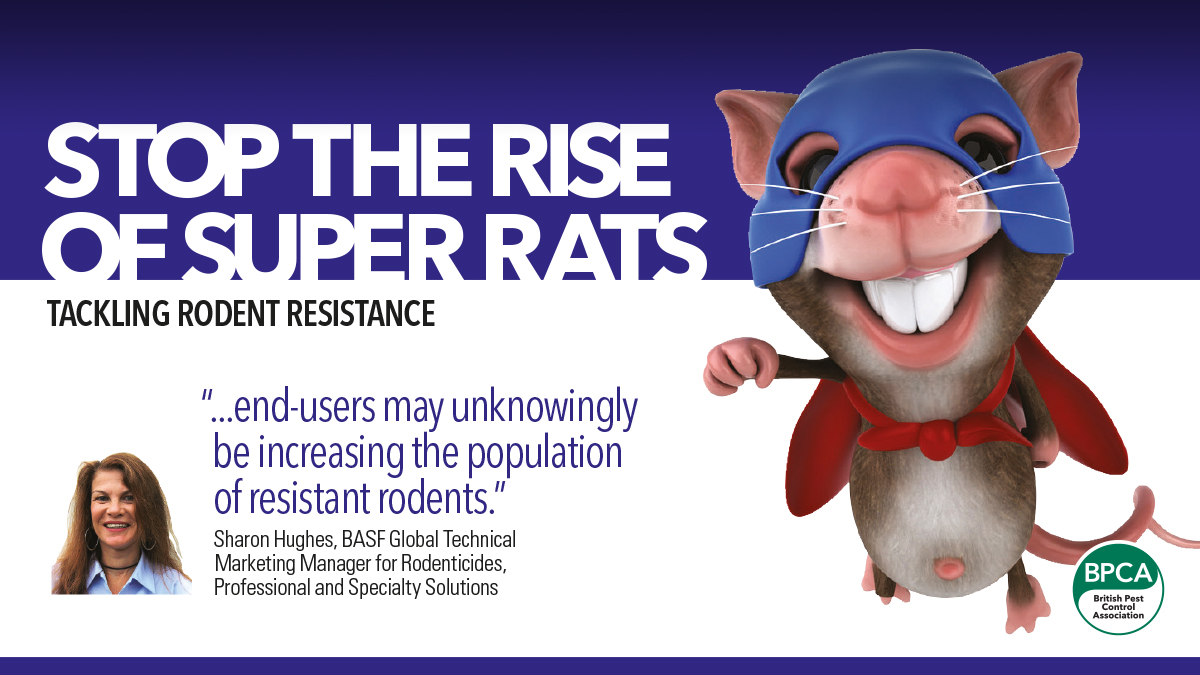TECHNICAL | PPC101 DECEMBER 2020
Rodent pests resistant to commonly used anticoagulant rodenticides have been identified in areas of the UK and the increase in numbers of these so-called ‘super rats’ presents a challenge to pest controllers. BPCA member BASF takes a look at how we keep on top of resistance issues.

Coumatetralyl, bromadiolone and difenacoum are the rodenticide actives present in many common and widely available rodenticide baits. However, these baits are proving ineffective against resistant rodents which are capable of eating large quantities of bait with no ill effects.
“Pest controllers must act now to help stop the spread of resistant rodents. This can be done by choosing methods of rodent control that are appropriate in their area and not using rodenticides containing the actives to which resistance already exists in their area,” says Sharon Hughes, BASF Global Technical Marketing Manager for Rodenticides, Professional and Specialty Solutions.
Establishing resistance levels in your area
Rats thrive when there is a plentiful supply of food, water and shelter. A breeding pair is capable of creating an infestation of 2,000 in just one year, making rats a concern for businesses and agriculture. Resistance has been compounded by using rodenticides without first establishing whether resistant rats are prevalent in the area.
Resistance is an issue that has been growing for years and many rodenticide users are unaware of whether it affects their region. The University of Reading Vertebrate Pests Unit (VPU) in conjunction with the Campaign for Responsible Rodenticide Use (CRRU) had been testing rat tail samples for the resistant gene but sadly the unit closed earlier this year.
Sharon Hughes, BASF Global Technical Marketing Manager for Rodenticides, Professional and Specialty Solutions
The VPU closed in June raising concerns that research into the spread of resistance would end. However, it was recently announced that the resistance testing will be conducted by the Animal and Plant Health Agency (APHA) at its laboratory in Weybridge, Surrey.
CRRU chairman, Dr Alan Buckle, is now encouraging pest controllers, farmers and gamekeepers, especially those who think they may have resistance problems, to send tail samples of freshly killed rats and mice. “The spread of resistance can only be tackled if we know where it is, and we are entirely dependent on people using this service for the data we need,” he says. “Otherwise, pest controllers, farmers and gamekeepers could be using products that are ineffective in places where rodents are resistant. And where resistance genes are still absent, others may be using resistance-breaking products unnecessarily. Only more samples can solve this,” he adds.
Selecting the right products for your area
Coumatetralyl, bromadiolone and difenacoum are actives used in popular multi-feed rodenticide baits. However, there are areas in the UK where rodents have shown resistance to these actives, so pest controllers are being advised to consult the rodent resistance map published on the Rodent Resistance Action Committee website rrac.info. There are three anticoagulant rodenticide actives that rodents have not developed resistance to. These are flocoumafen, brodifacoum and difethialone.
BASF has developed Storm® Ultra Secure, a wax-free formulation containing flocoumafen to offer the palatability of a soft block but the durability of a block. “Storm Ultra has been designed to be more palatable than Storm secure. It still contains flocoumafen, which rats have no known resistance to, and it can be used in and around buildings to overcome any resistance issues in certain areas,” says Sharon. “By continuing to use coumatetralyl, bromadiolone and difenacoum in areas with resistance, end-users may unknowingly be increasing the population of resistant rodents,” she adds.
The use of a bait to which some rats and mice are resistant will only be effective in controlling non-resistant rodents. This leaves only the resistant rodents surviving, which subsequently breed to produce a population of predominantly resistant rodents. “Compounding the problem in one location eventually causes these resistant rodents to spread to neighbouring sites. By using rodenticides with actives to which rodents have no known resistance, pest controllers can effectively control these rodents and help reduce the spread of resistance,” concludes Sharon.
Send in a tail sample to test for resistance
Tail samples can be sent by following advice on the CRRU website.
thinkwildlife.org/downloads

Source: PPC101